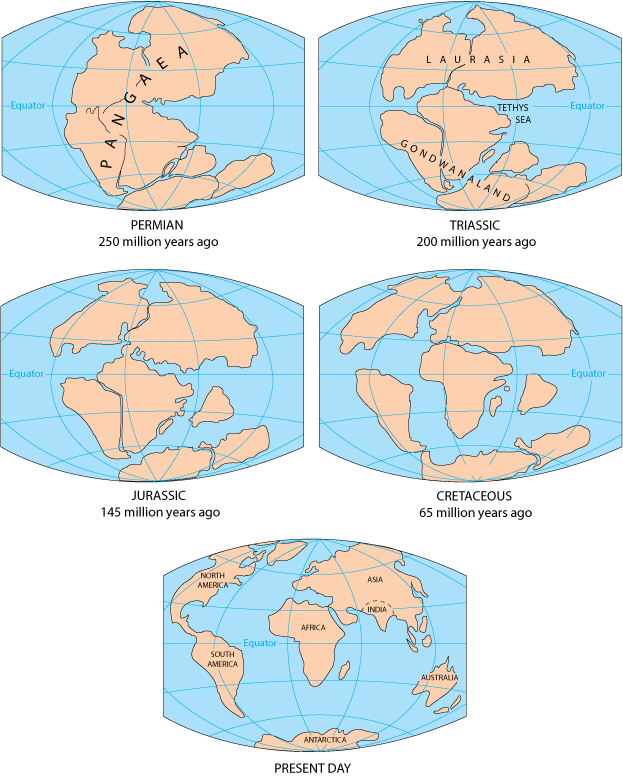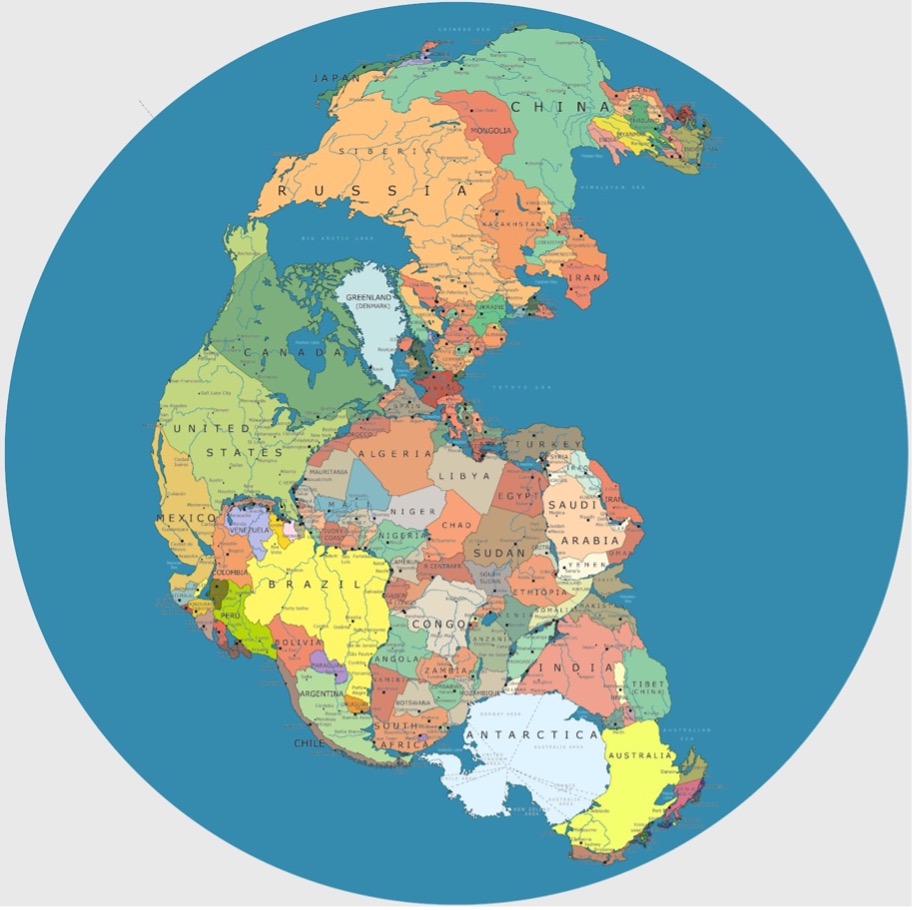Pangaea: The Last Supercontinent
Nikola Kostadinovski & Damian Pang | 18 November 2021
A Radically New Idea
Our planet’s surface shows an extraordinary diversity ranging from icy mountain peaks to rocky shores, and sandy deserts. Land is split up into the several large landmasses that we now consider continents as well as a multitude of islands1. It is not only the land that is divided, with it we find changes in climate, in biodiversity of both plants and animals, as well as distinct differences in culture, language, art, and politics. These seem old and unchanging divisions. But are they?
At the beginning of the 20th century, the German geophysicist Alfred Lothar Wegener (1880-1930)2 proposed a radical new theory: Continental drift. This new and revolutionary theory suggested that continents have slowly moved relative to each other, and in fact are still moving3! Wegener turned speculation that has been around for centuries into a coherent scientific theory4. Although he was mistaken about the underlying mechanics (which was developed by Arthur Holmes soon after5, his concept of continents moving apart led him to the conclusion that most of earth’s landmass was once combined a single, unified supercontinent. Wegener called it Pangaea, from the Greek for “all the earth6.”

What was Pangaea?
Pangaea (also known as Pangaea) was a enormous continental landmass that comprised all our current continents in an almost completely continuous terrestrial expanse7 that existed from ca. 320 to 180 million years ago8: It reached its full extent in the early Permian period (299-273 million years ago) and started breaking up around 200 million years ago during the early Jurassic period9. This massive C-shaped landmass was encircled by a ginormous ocean called Panthalassa (or Panthalassic Ocean) and surrounded the Tethys Sea in the east10. Pangaea’s large size meant that its interior was far away from any ocean, which resulted in a dry, desert-like centre with very hot days and super cold nights11. The continent was ravaged by super strong monsoon winds (called the Pangaean megamonsoon) that changed direction throughout the year12.
Unique Among Supercontinents
Pangaea’s large landmass is what geologists call a supercontinent13. More recent research indicates that Pangaea was not the only extensive landmass in earth’s history but that several supercontinents assembled and broke up in a repeating pattern called the supercontinent cycle14. The term supercontinent is a bit fuzzy but some researchers have defined it as any landmass that includes at least 75% of the continental crust in existence at the time15. All these criteria are based on Pangaea, the supercontinent we know most about and the first to be classified. It was the discovery of Pangaea that led to the acceptance of the theory of continental drift and Pangaea served as the archetype of what a supercontinent is16. Pangaea is also unique in other ways: It existed when the oxygen levels in the earth’s atmosphere reached its peak as vegetation flourished17. Along with the many plant species came a wide variety of animals, including several mass extinctions and subsequent flourishing of different species18.
Formation
Pangaea formed when the previously formed landmasses Gondwana in the south and Laurasia collided and formed a single, gigantic supercontinent19, 20through the movement of the underlying tectonic plates. The same process also resulted in its eventual breakup and the formation of the numerous, smaller continents we have today.

Conclusion
Pangaea was an ancient supercontinent that existed from ca. 320 to 180 million years ago. It included all major landmasses on earth today into a single, large terrestrial expanse.
About the Author
Nikola Kostadinovski is a geographer from Macedonia. He studied geography in Skopje at the St. Cyril and Methodius University with the faculty of mathematics and natural sciences. Nikola enjoys researching geography topics to update his knowledge, and also to teach and write on geography-related topics.
1 Pang, D. (2021). Continents. Sirius Geography. URL: TBA
2 Encyclopaedia Britannica (2021). Alfred Wegener. Encyclopedia Britannica. URL: https://www.britannica.com/biography/Alfred-Wegener
3 USGS. (2012). Historical perspective. USGS. URL: https://pubs.usgs.gov/gip/dynamic/historical.html
4 Romm, J. (1994). A new forerunner for continental drift. Nature, 367, 407–408. https://doi.org/10.1038/367407a0
5 Geological Society of Glasgow. (n.d.). Arthur Holmes. URL: https://geologyglasgow.org.uk/archive/arthur-holmes/
6 Harper, D. (n.d.). Etymology of Pangaea. Online Etymology Dictionary. URL: https://www.etymonline.com/word/Pangaea
7 Ghose, T. (2018). Facts about Pangaea, ancient supercontinent. LiveScience. URL: https://www.livescience.com/38218-facts-about-pangaea.html
8 Mitchell, R. N., et al. (2021). The supercontinent cycle. Nature Reviews Earth & Environment, 2, 358–374. https://doi.org/10.1038/s43017-021-00160-0
9 Encyclopaedia Britannica (2021). Pangaea. Encyclopedia Britannica. URL: https://www.britannica.com/place/Pangaea
10 Encyclopaedia Britannica (2021). Pangaea. Encyclopedia Britannica. URL: https://www.britannica.com/place/Pangaea
11 Parrish, J. T. (1993). Climate of the supercontinent Pangaea. Journal of Geology, 101(2), 215-233. https://doi.org/10.1086/648217
12 Soreghan, M. J., Soreghan, G. S. L., & Hamilton, M. A. (2002). Paleowinds inferred from detrital-zircon geochronology of upper Paleozoic loessite, western equatorial Pangaea. Geology, 30(8), 695–698. https://doi.org/10.1130/0091-7613(2002)030<0695:PIFDZG>2.0.CO;2
13 Mitchell, R. N., et al. (2021). The supercontinent cycle. Nature Reviews Earth & Environment, 2, 358–374. https://doi.org/10.1038/s43017-021-00160-0
14 Mitchell, R. N., et al. (2021). The supercontinent cycle. Nature Reviews Earth & Environment, 2, 358–374. https://doi.org/10.1038/s43017-021-00160-0
15 Meert, J. G. (2012). What’s in a name? The Columbia (PaleoPangaea/Nuna) supercontinent. Gondwana Research, 21(4), 987-993. https://doi.org/10.1016/j.gr.2011.12.002
16 Meert, J. G. (2012). What’s in a name? The Columbia (PaleoPangaea/Nuna) supercontinent. Gondwana Research, 21(4), 987-993. https://doi.org/10.1016/j.gr.2011.12.002
17 Mitchell, R. N., et al. (2021). The supercontinent cycle. Nature Reviews Earth & Environment, 2, 358–374. https://doi.org/10.1038/s43017-021-00160-0
18 Button, D. J. (2017). Mass extinctions drove increased global faunal cosmopolitanism on the supercontinent Pangaea. Nature Communications, 8, 733. https://doi.org/10.1038/s41467-017-00827-7
19 Lucas, S. G. (2005). Pangaea. In R. C. Selley et al. (Eds.) Encyclopedia of Geology (pp. 225-228). Cambridge, MA: Academic Press. https://doi.org/10.1016/B0-12-369396-9/00434-2
20 Rogers, J. J. W., & Santosh, M. (2004). Continents and supercontinents. Oxford, UK: Oxford University Press.